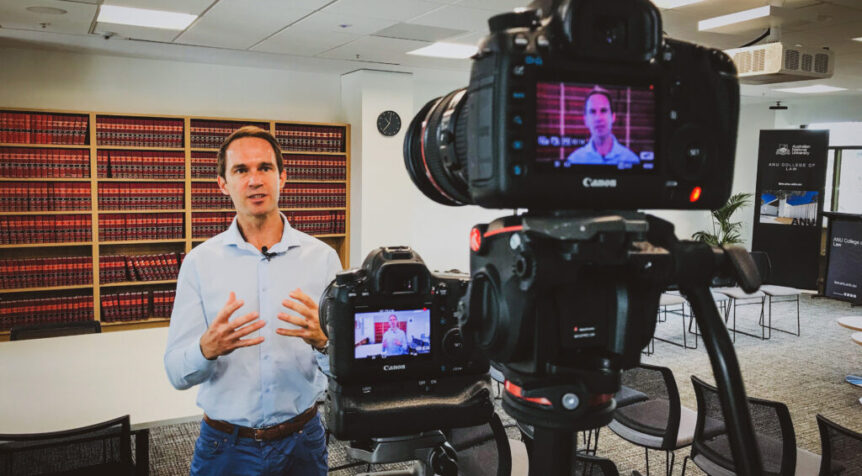You can, as it turns out, teach an old dog new tricks. Where those tricks relate to maximising engagement and interactivity in a large-group mixed-cohort first-year compulsory course, it is not hard to see why even the most experienced lecturers may be interested in exploring ideas and insights.
I convene a first-year compulsory law course, Torts, to a combined undergraduate LLB and post-grad JD cohort. Until the onset of Covid-19, I taught both on-campus and online, in large group lectures and also in compulsory smaller group weekly tutorials where we unpacked hypothetical liability scenarios.
In late 2019 Torts became the Law School pilot for the ANU Interactive Learning Project. The education designers in the Centre for Learning and Teaching hardly blinked at the daunting task of how to help a fairly old dog find new ways, technology-enhanced or other, to boost interactive learning while differentiating between cohorts in ways that were sustainable and potentially replicable in other law compulsory courses.
The teaching challenge in Torts was not the subject matter—which is not dry and doctrinal—but rather a series of fascinating stories around cutting-edge social themes, including:
- Is a camera-equipped drone hovering over my land in ‘trespass’ to it?
- When is a school, which has taken every possible care in its hiring process, potentially liable for the intentional criminal wrongs of a teacher engaged in child abuse?
- Should a social dinner host owe a legal duty of care to his guests in relation to the injuries they might suffer en route home after leaving the host’s premises drunk?
- Can someone claim compensation for negligently inflicted loss of life expectancy if they are in a permanent coma and so unaware of their loss?
The challenge was not that the material was not engaging—it was the sheer volume of case-law and statutory material to be read; the cohort’s size and differentiated make-up; and the expectations of first-year law students that law studies are, or ought to be, individualistic and competitive, with the all-knowing professor directly instructing them on all required content and skills.
With the iLEAP team we shifted from Wattle to the smoother Articulate interface and focussed on preparing pre-topic and pre-lecture materials suitable for multi-year use. These aimed both to prime students to approach new concepts through higher-order thinking, and to whet their appetite with interesting material, drawing them to the full readings and to lectures themselves (‘I wonder what happens next in this lawsuit!?’).
Along with minor tweaks such as various optional quizzes and mini-quiz flashcards to instantly self-test the grasp of a new concept, a key feature was recorded a series of videos between 6 and 15 minutes using the iLEAP Lightboard. These videos outlined in a visually compelling way the complex factual matrix of key law cases, thereby freeing up lecture time to focus on the liability principles raised.
With multi-party personal injury cases, many students relate more easily to a visual scenario and can project onto that their emerging understanding of concepts such as ‘reasonable care’ or ‘sufficiently close relationship’. You can see other examples of our Torts Lightboard videos here and here.
We also created a pre-course video (above) and another video about the assessment design and course logistics. This freed up Lecture 1 which was the very first law lecture for many of them, to focus on introducing key themes about Torts and its societal purpose, through stimulating discussion on these issues and setting the tone for subsequent interactivity.
The videos included explicit reflections on the research-based rationale for course design choices, treating students as adults but also explaining why, in taking responsibility for their own learning, they would likely be deepening that learning.
The Covid-19 -related shift online meant that many in-class iLEAP activities such as live polling and discussion did not roll out as planned, however in taking the course wholly online, we could innovate with Wiki-based Wattle tools for small-group student sets to practice answer outlines with tutor feedback, and other interventions.
Meanwhile the choice to include assessed small-group assignments based on discussion forums in formative tasks meant that students were engaged with each other, even once they were dispersed and the campus closed.
Students are never the only learners in a university course. The convenor/lecturer also learns —from student interaction, through different ways of seeing concepts or issues, and with each course iteration different ways to approach teaching. University lecturers can be very protective of their courses and classroom environments, yet the great gift of the iLEAP team was their ability to excite one with evidence-based(!) possibilities for tweaking or fundamentally redesigning aspects of how a course is designed, taught and assessed. Their skill was to get a fairly ‘old dog’ like me, not just to do new tricks, but to want to teach himself how to do so, and to encourage others in the teaching pack to try.

July 2020
Jolyon Ford is the Convenor of Torts in the ANU College of Law, and worked with the Education Design and Multimedia teams in the ANU Centre for Learning and Teaching (CLT)
View a showcase of Lightboard example videos here and if you are interested in using one or finding out more please contact the iLEAP team. A big thank you to Ivo Verkermans who created the Lightboard that is being used.

